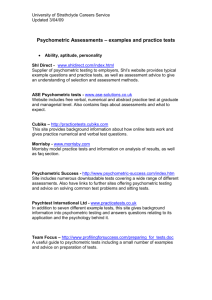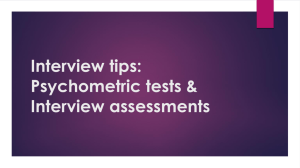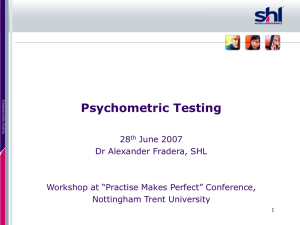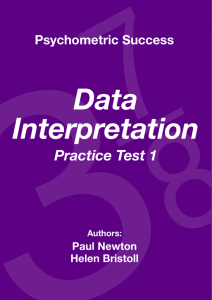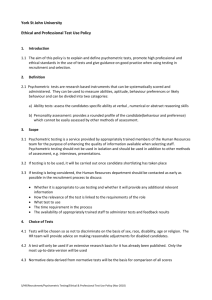Psychometric Modeling of Decision Making Via Game Play Kenneth W. Regan
advertisement
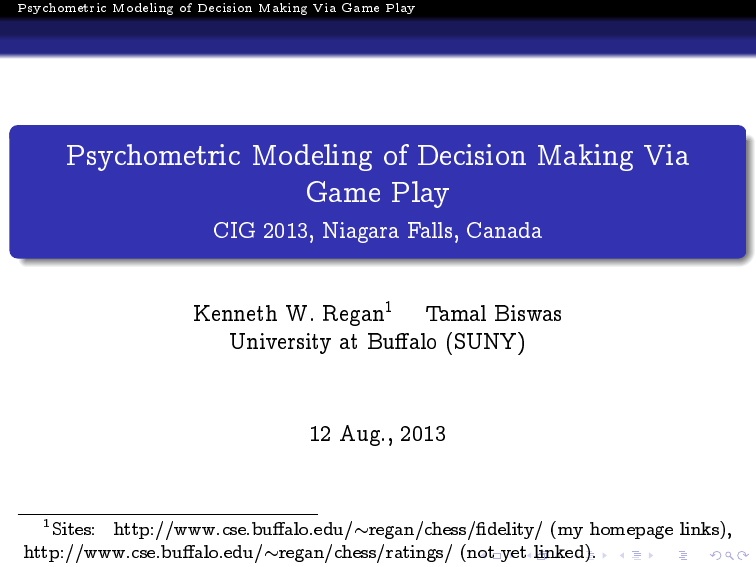
Psychometric Modeling of Decision Making Via Game Play Psychometric Modeling of Decision Making Via Game Play CIG 2013, Niagara Falls, Canada Kenneth W. Regan 1 Tamal Biswas University at Bualo (SUNY) 12 Aug., 2013 Sites: http://www.cse.bualo.edu/regan/chess/delity/ (my homepage links), http://www.cse.bualo.edu/regan/chess/ratings/ (not yet linked). 1 Psychometric Modeling of Decision Making Via Game Play A Predictive Analytic Model 1 Domain: A set of decision-making situations t . Chess game turns Psychometric Modeling of Decision Making Via Game Play A Predictive Analytic Model 1 Domain: A set of decision-making situations t . Chess game turns 2 i Inputs: Values v for every option at turn t . Computer values of moves m i Psychometric Modeling of Decision Making Via Game Play A Predictive Analytic Model 1 Domain: A set of decision-making situations t . Chess game turns 2 i Inputs: Values v for every option at turn t . Computer values of moves m 3 i Parameters: s ; c ; : : : denoting skills and levels. Trained correspondence to chess Elo rating E Psychometric Modeling of Decision Making Via Game Play A Predictive Analytic Model 1 Domain: A set of decision-making situations t . Chess game turns 2 i Inputs: Values v for every option at turn t . Computer values of moves m 3 i Parameters: s ; c ; : : : denoting skills and levels. Trained correspondence to chess Elo rating E 4 ( ) Denes fallible agent P s ; c ; : : : . A Player. Psychometric Modeling of Decision Making Via Game Play A Predictive Analytic Model 1 Domain: A set of decision-making situations t . Chess game turns 2 i Inputs: Values v for every option at turn t . Computer values of moves m 3 i Parameters: s ; c ; : : : denoting skills and levels. Trained correspondence to chess Elo rating E ( ) 4 Denes fallible agent P s ; c ; : : : . A Player. 5 Main Output: Probabilities p turn t . ti ; ( for P s ; c ; : : : ) to select option i at Psychometric Modeling of Decision Making Via Game Play A Predictive Analytic Model 1 Domain: A set of decision-making situations t . Chess game turns 2 i Inputs: Values v for every option at turn t . Computer values of moves m 3 i Parameters: s ; c ; : : : denoting skills and levels. Trained correspondence to chess Elo rating E ( ) 4 Denes fallible agent P s ; c ; : : : . A Player. 5 Main Output: Probabilities p turn t . 6 ti ; ( for P s ; c ; : : : ) to select option i at Derived Outputs: Aggregate statistics: move-match MM, average error AE, . . . Projected condence intervals for those statistics. Intrinsic Performance Ratings (IPR's). Psychometric Modeling of Decision Making Via Game Play Data Sample Houdini 3, 32-pv mode, basic search depth 17 ply = 8-1/2 moves. FEN: 2r3k1/1p1r3p/p5pR/P3pp2/3Pq3/2P1P3/1P1Q1RPP/6K1 b - - 0 32 dp/ex value diff move and PV ... 17/53 +0.18 0.37 32...exd4 33.exd4 Re7... 17/53 +0.11 0.30 32...Rc4 33.g3 Ra4... 17/53 +0.08 0.27 32...Qb1+ 33.Rf1 Qa2... 17/53 +0.04 0.23 32...Qd5 33.Rh3 Re7... 17/53 +0.04 0.23 32...Re7 33.Rh3 Qd5... 17/53 0.00 0.19 32...Kg7 33.Rh3 Rc5... 17/53 -0.19 0.00 32...Rc5 33.b4 Rc4... Best move at bottom, 19 centipawn advantage to Black, to move. These numbers and the move actually played (which was 32...Rc5) are the only chess-dependent inputs to the model. Hence adaptable to any decision game with fungible values. Psychometric Modeling of Decision Making Via Game Play Two Skill Parameters, Universal? Sensitivity s divides eval-units to yield dimensionless quantities: xi = (vs1 vi ) ; : Consistency c magnies high and low values of xi . Current model: ( ( ) )i = log 1=p1 log 1=p exp ( c ): xi i Higher c makes the right-hand tinier, so p tinier, thus reducing the frequency of blunders. Tactical i Lower s has a stronger eect on x i when x slight dierences. Positional Depth parameters are under development. is small, picking out Psychometric Modeling of Decision Making Via Game Play Isomorphism With a Rasch Application Decision Making in Game Play Multiple-Choice Tests 1 Values for move choices 1 Point credits for (all) answers 2 Move-match (MM) score 2 Best-answer score 3 Avg.-Error (AE) score 3 Partial-credit score 4 P -parameters 4 Aptitude parameters (position) 5 Model projections 5 Diculty of question Weight of question 6 Game criticality of position 6 7 Intrinsic Perf. Rating (IPR) 7 Grade assessment 8 Moment statistics, condence. 8 Grade distribution analysis. Goal: Cross-fertilize the rich data and theory between psychometrics and games. Psychometric Modeling of Decision Making Via Game Play General Game Play Pertinence (mostly future) 1 ( How well does P s ; c ; : : : skill set? ) simulate a human player of the given Psychometric Modeling of Decision Making Via Game Play General Game Play Pertinence (mostly future) 1 ( How well does P s ; c ; : : : ) simulate a human player of the given skill set? 2 Garry Kasparov's Turing Test: he was able to distinguish games played by (older-and-weaker) computer-played games from human ( ones. Would P s ; c ; : : : ) pass it? Psychometric Modeling of Decision Making Via Game Play General Game Play Pertinence (mostly future) 1 ( How well does P s ; c ; : : : ) simulate a human player of the given skill set? 2 Garry Kasparov's Turing Test: he was able to distinguish games played by (older-and-weaker) computer-played games from human ( ones. Would P s ; c ; : : : ) pass it? 3 Intrinsic estimates of position diculty? 4 Relate human performance to diculty statistically. Psychometric Modeling of Decision Making Via Game Play General Game Play Pertinence (mostly future) 1 ( How well does P s ; c ; : : : ) simulate a human player of the given skill set? 2 Garry Kasparov's Turing Test: he was able to distinguish games played by (older-and-weaker) computer-played games from human ( ones. Would P s ; c ; : : : ) pass it? 3 Intrinsic estimates of position diculty? 4 Relate human performance to diculty statistically. 5 Inuence of thinking time on skill. Psychometric Modeling of Decision Making Via Game Play General Game Play Pertinence (mostly future) 1 ( How well does P s ; c ; : : : ) simulate a human player of the given skill set? 2 Garry Kasparov's Turing Test: he was able to distinguish games played by (older-and-weaker) computer-played games from human ( ones. Would P s ; c ; : : : ) pass it? 3 Intrinsic estimates of position diculty? 4 Relate human performance to diculty statistically. 5 Inuence of thinking time on skill. 6 Behavior as a function of being ahead/behind/equal: Cognitive Bias or Rational Risk-Taking? Psychometric Modeling of Decision Making Via Game Play General Game Play Pertinence (mostly future) 1 ( How well does P s ; c ; : : : ) simulate a human player of the given skill set? 2 Garry Kasparov's Turing Test: he was able to distinguish games played by (older-and-weaker) computer-played games from human ( ones. Would P s ; c ; : : : ) pass it? 3 Intrinsic estimates of position diculty? 4 Relate human performance to diculty statistically. 5 Inuence of thinking time on skill. 6 Behavior as a function of being ahead/behind/equal: Cognitive Bias or Rational Risk-Taking? 7 Game quality with unevenly-matched players. Psychometric Modeling of Decision Making Via Game Play Chess Elo Ratings Based on results of games (only): win, lose, draw. Numbers have only relative meaning. A 200-point dierence 75% expectation for the winner (now closer to 76%): Class Unit (László Mér®). Psychometric Modeling of Decision Making Via Game Play Chess Elo Ratings Based on results of games (only): win, lose, draw. Numbers have only relative meaning. A 200-point dierence 75% expectation for the winner (now closer to 76%): Class Unit (László Mér®). USCF: 2400 = Senior Master, 2200 = Master, 2000 = Expert, 1800 = Class A, ..., 1200 = Class D, 1000 = Class E. Beginner might be 600, but kids push below USCF's 100 oor. Psychometric Modeling of Decision Making Via Game Play Chess Elo Ratings Based on results of games (only): win, lose, draw. Numbers have only relative meaning. A 200-point dierence 75% expectation for the winner (now closer to 76%): Class Unit (László Mér®). USCF: 2400 = Senior Master, 2200 = Master, 2000 = Expert, 1800 = Class A, ..., 1200 = Class D, 1000 = Class E. Beginner might be 600, but kids push below USCF's 100 oor. Highest human (FIDE) rating is 2870, about fty have 2700+. Computer programs have 3200+ (CCRL), even on cheap hardware. Psychometric Modeling of Decision Making Via Game Play Chess Elo Ratings Based on results of games (only): win, lose, draw. Numbers have only relative meaning. A 200-point dierence 75% expectation for the winner (now closer to 76%): Class Unit (László Mér®). USCF: 2400 = Senior Master, 2200 = Master, 2000 = Expert, 1800 = Class A, ..., 1200 = Class D, 1000 = Class E. Beginner might be 600, but kids push below USCF's 100 oor. Highest human (FIDE) rating is 2870, about fty have 2700+. Computer programs have 3200+ (CCRL), even on cheap hardware. Advantages of IPR: independent of opponent's play 50-100 games per year yield 1,5003,000 relevant moves. Psychometric Modeling of Decision Making Via Game Play IPR Psychometric Procedure A performance by a human player Q at international level is typically 910 games, giving a set T of about 250300 analyzed game turns. Psychometric Modeling of Decision Making Via Game Play IPR Psychometric Procedure A performance by a human player Q at international level is typically 910 games, giving a set T of about 250300 analyzed game turns. 1 ( ) Run regression over T to nd the closest agent P s ; c ; : : : . Psychometric Modeling of Decision Making Via Game Play IPR Psychometric Procedure A performance by a human player Q at international level is typically 910 games, giving a set T of about 250300 analyzed game turns. ( ) 1 Run regression over T to nd the closest agent P s ; c ; : : : . 2 Calculate a e positions. = the projected AE of P on a xed reference set S of Psychometric Modeling of Decision Making Via Game Play IPR Psychometric Procedure A performance by a human player Q at international level is typically 910 games, giving a set T of about 250300 analyzed game turns. ( ) 1 Run regression over T to nd the closest agent P s ; c ; : : : . 2 Calculate a e = the projected AE of P on a xed reference set S of positions. 3 Read IPR(a ) from the model's training t to human players. Psychometric Modeling of Decision Making Via Game Play IPR Psychometric Procedure A performance by a human player Q at international level is typically 910 games, giving a set T of about 250300 analyzed game turns. ( ) 1 Run regression over T to nd the closest agent P s ; c ; : : : . 2 Calculate a e = the projected AE of P on a xed reference set S of positions. 3 Read IPR(a ) from the model's training t to human players. With unit weighting of decisions (all questions equal value, regardless of criticality or diculty), the current best-t regression to Elo rating is almost exactly: IPR = 3475 a 14 000 ; : Psychometric Modeling of Decision Making Via Game Play IPR Psychometric Procedure A performance by a human player Q at international level is typically 910 games, giving a set T of about 250300 analyzed game turns. ( ) 1 Run regression over T to nd the closest agent P s ; c ; : : : . 2 Calculate a e = the projected AE of P on a xed reference set S of positions. 3 Read IPR(a ) from the model's training t to human players. With unit weighting of decisions (all questions equal value, regardless of criticality or diculty), the current best-t regression to Elo rating is almost exactly: IPR = 3475 a 14 000 ; : Error Bars of measurement are based on the run over T . Psychometric Modeling of Decision Making Via Game Play Deviation Test Procedure : (for cheating) Given player Q of rating E performing on positions T : Psychometric Modeling of Decision Making Via Game Play Deviation Test Procedure : (for cheating) Given player Q of rating E performing on positions T : 1 Q ; cQ Choose parameters s appropriate to Q (corresp. to E ). Psychometric Modeling of Decision Making Via Game Play Deviation Test Procedure : (for cheating) Given player Q of rating E performing on positions T : 1 2 Q ; cQ appropriate to Q Compute projections mQ , aQ on T . Choose parameters s (corresp. to E ). Psychometric Modeling of Decision Making Via Game Play Deviation Test Procedure : (for cheating) Given player Q of rating E performing on positions T : 1 2 3 4 Q ; cQ appropriate to Q (corresp. to E ). Compute projections mQ , aQ on T . Also get condence intervals em , ea (also depend on sQ ; cQ ). Choose parameters s ^ ^ Compare with actual m , a on T to get z-scores. Psychometric Modeling of Decision Making Via Game Play Deviation Test Procedure : (for cheating) Given player Q of rating E performing on positions T : 1 2 3 4 Q ; cQ appropriate to Q (corresp. to E ). Compute projections mQ , aQ on T . Also get condence intervals em , ea (also depend on sQ ; cQ ). Choose parameters s ^ ^ Compare with actual m , a on T to get z-scores. Q ; cQ Deviation test error itself is minimal, since s m , ea large-scale training ts. Hence e are from can set z -scores. Psychometric Modeling of Decision Making Via Game Play Deviation Test Procedure : (for cheating) Given player Q of rating E performing on positions T : 1 2 3 4 Q ; cQ appropriate to Q (corresp. to E ). Compute projections mQ , aQ on T . Also get condence intervals em , ea (also depend on sQ ; cQ ). Choose parameters s ^ ^ Compare with actual m , a on T to get z-scores. Q ; cQ Deviation test error itself is minimal, since s m , ea large-scale training ts. Hence e are from can set z -scores. Empirical testing on 10,000s of random 9-game subsets of training data, and actual player-performances, suggests adjustment factors. Psychometric Modeling of Decision Making Via Game Play Deviation Test Procedure : (for cheating) Given player Q of rating E performing on positions T : 1 2 3 4 Q ; cQ appropriate to Q (corresp. to E ). Compute projections mQ , aQ on T . Also get condence intervals em , ea (also depend on sQ ; cQ ). Choose parameters s ^ ^ Compare with actual m , a on T to get z-scores. Q ; cQ Deviation test error itself is minimal, since s m , ea large-scale training ts. Hence e are from can set z -scores. Empirical testing on 10,000s of random 9-game subsets of training data, and actual player-performances, suggests adjustment factors. Game decisions modeled as independent, but really have Sparse j j Dependence. Adjustment reects lower eective sample size T . Psychometric Modeling of Decision Making Via Game Play Results and Interpretations 1 Training done on games with both players within century-point, 2200, 2300, 2400, 2500, 2600, 2700. 10 of an Elo Psychometric Modeling of Decision Making Via Game Play Results and Interpretations 1 Training done on games with both players within 10 of an Elo century-point, 2200, 2300, 2400, 2500, 2600, 2700. 2 IPRs spot-on with average rating in world-champonship matches, almost all above 2700 strength. Psychometric Modeling of Decision Making Via Game Play Results and Interpretations 1 Training done on games with both players within 10 of an Elo century-point, 2200, 2300, 2400, 2500, 2600, 2700. 2 IPRs spot-on with average rating in world-champonship matches, 3 Even IPRs of computers make sense (though error bars almost all above 2700 strength. Deep Thought in 1991: 2150. 200300): Psychometric Modeling of Decision Making Via Game Play Results and Interpretations 1 Training done on games with both players within 10 of an Elo century-point, 2200, 2300, 2400, 2500, 2600, 2700. 2 IPRs spot-on with average rating in world-champonship matches, 3 Even IPRs of computers make sense (though error bars almost all above 2700 strength. Deep Thought in 1991: 2150. Deep Blue in 199697: 28502900. 200300): Psychometric Modeling of Decision Making Via Game Play Results and Interpretations 1 Training done on games with both players within 10 of an Elo century-point, 2200, 2300, 2400, 2500, 2600, 2700. 2 IPRs spot-on with average rating in world-champonship matches, 3 Even IPRs of computers make sense (though error bars almost all above 2700 strength. Deep Thought in 1991: 2150. Deep Blue in 199697: 28502900. Hydra in 2005: 3150 200300): Psychometric Modeling of Decision Making Via Game Play Results and Interpretations 1 Training done on games with both players within 10 of an Elo century-point, 2200, 2300, 2400, 2500, 2600, 2700. 2 IPRs spot-on with average rating in world-champonship matches, 3 Even IPRs of computers make sense (though error bars almost all above 2700 strength. Deep Thought in 1991: 2150. Deep Blue in 199697: 28502900. Hydra in 2005: 3150 Deep Fritz 10 on 4-core PC in 2006: 2980. 200300): Psychometric Modeling of Decision Making Via Game Play Results and Interpretations 1 Training done on games with both players within 10 of an Elo century-point, 2200, 2300, 2400, 2500, 2600, 2700. 2 IPRs spot-on with average rating in world-champonship matches, 3 Even IPRs of computers make sense (though error bars almost all above 2700 strength. 200300): Deep Thought in 1991: 2150. Deep Blue in 199697: 28502900. Hydra in 2005: 3150 Deep Fritz 10 on 4-core PC in 2006: 2980. 4 Tournaments, however, regularly have IPRs 20-30 below their average ratings. Psychometric Modeling of Decision Making Via Game Play Results and Interpretations 1 Training done on games with both players within 10 of an Elo century-point, 2200, 2300, 2400, 2500, 2600, 2700. 2 IPRs spot-on with average rating in world-champonship matches, 3 Even IPRs of computers make sense (though error bars almost all above 2700 strength. 200300): Deep Thought in 1991: 2150. Deep Blue in 199697: 28502900. Hydra in 2005: 3150 Deep Fritz 10 on 4-core PC in 2006: 2980. 4 Tournaments, however, regularly have IPRs 20-30 below their average ratings. 5 Perhaps owes to higher average rating dierence in games? Psychometric Modeling of Decision Making Via Game Play Results and Interpretations 1 Training done on games with both players within 10 of an Elo century-point, 2200, 2300, 2400, 2500, 2600, 2700. 2 IPRs spot-on with average rating in world-champonship matches, 3 Even IPRs of computers make sense (though error bars almost all above 2700 strength. 200300): Deep Thought in 1991: 2150. Deep Blue in 199697: 28502900. Hydra in 2005: 3150 Deep Fritz 10 on 4-core PC in 2006: 2980. 4 Tournaments, however, regularly have IPRs 20-30 below their average ratings. 5 Perhaps owes to higher average rating dierence in games? 6 Human IPR's rarely above 3000... Psychometric Modeling of Decision Making Via Game Play Results and Interpretations 1 Training done on games with both players within 10 of an Elo century-point, 2200, 2300, 2400, 2500, 2600, 2700. 2 IPRs spot-on with average rating in world-champonship matches, 3 Even IPRs of computers make sense (though error bars almost all above 2700 strength. 200300): Deep Thought in 1991: 2150. Deep Blue in 199697: 28502900. Hydra in 2005: 3150 Deep Fritz 10 on 4-core PC in 2006: 2980. 4 Tournaments, however, regularly have IPRs 20-30 below their average ratings. 5 Perhaps owes to higher average rating dierence in games? 6 Human IPR's rarely above 3000... except for some players named Feller, Ivanov, Kotainy... Psychometric Modeling of Decision Making Via Game Play Results and Interpretations 1 Training done on games with both players within 10 of an Elo century-point, 2200, 2300, 2400, 2500, 2600, 2700. 2 IPRs spot-on with average rating in world-champonship matches, 3 Even IPRs of computers make sense (though error bars almost all above 2700 strength. 200300): Deep Thought in 1991: 2150. Deep Blue in 199697: 28502900. Hydra in 2005: 3150 Deep Fritz 10 on 4-core PC in 2006: 2980. 4 Tournaments, however, regularly have IPRs 20-30 below their average ratings. 5 Perhaps owes to higher average rating dierence in games? 6 Human IPR's rarely above 3000... except for some players named Feller, Ivanov, Kotainy... or most of the 2010 Azov Don Cup. Psychometric Modeling of Decision Making Via Game Play Lessons for Estimating Diculty in Games First idea: Diculty of a position t = expected error on t , perhaps weighted by how critical. Psychometric Modeling of Decision Making Via Game Play Lessons for Estimating Diculty in Games First idea: Diculty of a position t = expected error on t , perhaps weighted by how critical. Issue: error by whom? Psychometric Modeling of Decision Making Via Game Play Lessons for Estimating Diculty in Games First idea: Diculty of a position t = expected error on t , perhaps weighted by how critical. Issue: error by whom? Can be by a reference player P0 . Psychometric Modeling of Decision Making Via Game Play Lessons for Estimating Diculty in Games First idea: Diculty of a position t = expected error on t , perhaps weighted by how critical. Issue: error by whom? Can be by a reference player P0 . (Can alternately dene IPR as performance relative to P0 .) Psychometric Modeling of Decision Making Via Game Play Lessons for Estimating Diculty in Games First idea: Diculty of a position t = expected error on t , perhaps weighted by how critical. Issue: error by whom? Can be by a reference player P0 . (Can alternately dene IPR as performance relative to P0 .) But what level to use for P0 ? Psychometric Modeling of Decision Making Via Game Play Lessons for Estimating Diculty in Games First idea: Diculty of a position t = expected error on t , perhaps weighted by how critical. Issue: error by whom? Can be by a reference player P0 . (Can alternately dene IPR as performance relative to P0 .) But what level to use for P0 ? ( Can integrate error over whole P s ; c ; : : : ) parameter space, Psychometric Modeling of Decision Making Via Game Play Lessons for Estimating Diculty in Games First idea: Diculty of a position t = expected error on t , perhaps weighted by how critical. Issue: error by whom? Can be by a reference player P0 . (Can alternately dene IPR as performance relative to P0 .) But what level to use for P0 ? ( Can integrate error over whole P s ; c ; : : : how weighted? Or not a simple scalar... ) parameter space, but Psychometric Modeling of Decision Making Via Game Play Lessons for Estimating Diculty in Games First idea: Diculty of a position t = expected error on t , perhaps weighted by how critical. Issue: error by whom? Can be by a reference player P0 . (Can alternately dene IPR as performance relative to P0 .) But what level to use for P0 ? ( Can integrate error over whole P s ; c ; : : : ) parameter space, but how weighted? Or not a simple scalar... Instead try to correlate observed diculty with intrinsic features of the game position... Psychometric Modeling of Decision Making Via Game Play Lessons for Estimating Diculty in Games First idea: Diculty of a position t = expected error on t , perhaps weighted by how critical. Issue: error by whom? Can be by a reference player P0 . (Can alternately dene IPR as performance relative to P0 .) But what level to use for P0 ? ( Can integrate error over whole P s ; c ; : : : ) parameter space, but how weighted? Or not a simple scalar... Instead try to correlate observed diculty with intrinsic features of the game position... such as how much values swing as analysis depth changes. Psychometric Modeling of Decision Making Via Game Play Some Further Ideas 1 Characterize styles of both human players and 'bots in the ( P s ; c; : : : ) space. Psychometric Modeling of Decision Making Via Game Play Some Further Ideas 1 Characterize styles of both human players and 'bots in the ( P s ; c; : : : 2 ) space. Is there a Fischer Fingerprint? Psychometric Modeling of Decision Making Via Game Play Some Further Ideas 1 Characterize styles of both human players and 'bots in the ( P s ; c; : : : 2 ) space. Is there a Fischer Fingerprint? Suppose 9 new games turn up, and someone claims they were played by Fischer in a previously-unknown tournament before 1970. Psychometric Modeling of Decision Making Via Game Play Some Further Ideas 1 Characterize styles of both human players and 'bots in the ( P s ; c; : : : 2 ) space. Is there a Fischer Fingerprint? Suppose 9 new games turn up, and someone claims they were played by Fischer in a previously-unknown tournament before 1970. With few parametersand many playersprobably someone else's games would be a closer match even if they were played by Fischer. Psychometric Modeling of Decision Making Via Game Play Some Further Ideas 1 Characterize styles of both human players and 'bots in the ( P s ; c; : : : 2 ) space. Is there a Fischer Fingerprint? Suppose 9 new games turn up, and someone claims they were played by Fischer in a previously-unknown tournament before 1970. With few parametersand many playersprobably someone else's games would be a closer match even if they were played by Fischer. Similar issue with authorship disputes: Peter Millican re: J.K. Rowling in 19 July, 2013 interview with Canada's Day 6 programme. Psychometric Modeling of Decision Making Via Game Play Some Further Ideas 1 Characterize styles of both human players and 'bots in the ( P s ; c; : : : 2 ) space. Is there a Fischer Fingerprint? Suppose 9 new games turn up, and someone claims they were played by Fischer in a previously-unknown tournament before 1970. With few parametersand many playersprobably someone else's games would be a closer match even if they were played by Fischer. Similar issue with authorship disputes: Peter Millican re: J.K. Rowling in 19 July, 2013 interview with Canada's Day 6 programme. 3 Distinguishing two far-apart styles is easier (e.g. human computer). ! Psychometric Modeling of Decision Making Via Game Play Some Further Ideas 1 Characterize styles of both human players and 'bots in the ( P s ; c; : : : 2 ) space. Is there a Fischer Fingerprint? Suppose 9 new games turn up, and someone claims they were played by Fischer in a previously-unknown tournament before 1970. With few parametersand many playersprobably someone else's games would be a closer match even if they were played by Fischer. Similar issue with authorship disputes: Peter Millican re: J.K. Rowling in 19 July, 2013 interview with Canada's Day 6 programme. 3 Distinguishing two far-apart styles is easier (e.g. human computer). 4 How to make (fallible) 'bots more human-realistic? ! Psychometric Modeling of Decision Making Via Game Play Some Further Ideas 1 Characterize styles of both human players and 'bots in the ( P s ; c; : : : 2 ) space. Is there a Fischer Fingerprint? Suppose 9 new games turn up, and someone claims they were played by Fischer in a previously-unknown tournament before 1970. With few parametersand many playersprobably someone else's games would be a closer match even if they were played by Fischer. Similar issue with authorship disputes: Peter Millican re: J.K. Rowling in 19 July, 2013 interview with Canada's Day 6 programme. 3 Distinguishing two far-apart styles is easier (e.g. human computer). 4 How to make (fallible) 'bots more human-realistic? 5 Tame the curve of fallibility. . . ! Psychometric Modeling of Decision Making Via Game Play In Conclusion Main tenet of the model: Psychometric Modeling of Decision Making Via Game Play In Conclusion Main tenet of the model: Human decision making (and physiological reactivity) ought to be governed in the large by relatively simple mathematical laws Psychometric Modeling of Decision Making Via Game Play In Conclusion Main tenet of the model: Human decision making (and physiological reactivity) ought to be governed in the large by relatively simple mathematical lawslaws that are independent of details of any particular game, Psychometric Modeling of Decision Making Via Game Play In Conclusion Main tenet of the model: Human decision making (and physiological reactivity) ought to be governed in the large by relatively simple mathematical lawslaws that are independent of details of any particular game, and hence ought to be revealed as common properties between games. Psychometric Modeling of Decision Making Via Game Play In Conclusion Main tenet of the model: Human decision making (and physiological reactivity) ought to be governed in the large by relatively simple mathematical lawslaws that are independent of details of any particular game, and hence ought to be revealed as common properties between games. And many activities in life are games. Psychometric Modeling of Decision Making Via Game Play In Conclusion Main tenet of the model: Human decision making (and physiological reactivity) ought to be governed in the large by relatively simple mathematical lawslaws that are independent of details of any particular game, and hence ought to be revealed as common properties between games. And many activities in life are games. The results so far show that this expectation is plausible.
